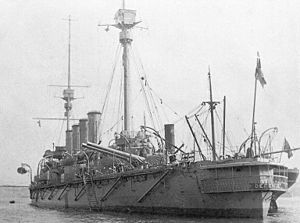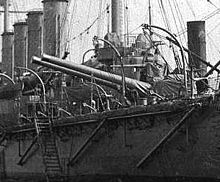HMS Defence (1907)
 Stern view of Defence
| |
| History | |
|---|---|
| Name | Defence |
| Ordered | 1904-05 Naval Programme |
| Builder | Pembroke dockyard |
| Laid down | 25 February 1905 |
| Launched | 24 April 1907 |
| Commissioned | 9 February 1909 |
| Fate | Sunk at the Battle of Jutland, 31 May 1916 |
| General characteristics | |
| Class and type | Minotaur-class armoured cruiser |
| Displacement | 14,600 long tons (14,800 t) |
| Length | |
| Beam | 74.5 ft (22.7 m) |
| Draught | 26 ft (7.9 m) |
| Installed power |
|
| Propulsion | |
| Speed | 23 knots (43 km/h; 26 mph) |
| Range | 8,150 nmi (15,090 km; 9,380 mi) at 10 knots (19 km/h; 12 mph) |
| Complement | 779 |
| Armament |
|
| Armour |
|
HMS Defence was a Minotaur-class armoured cruiser built for the Royal Navy in the first decade of the 20th century, the last armoured cruiser built for the Royal Navy. She was stationed in the Mediterranean when the First World War began and participated in the pursuit of the German battlecruiser SMS Goeben and light cruiser SMS Breslau. The ship was transferred to the Grand Fleet in January 1915 and remained there for the rest of her career.
Defence was sunk on 31 May 1916 during the Battle of Jutland, the largest naval battle of the war. Escorting the main body of the Grand Fleet, the ship was fired upon by one German battlecruiser and four dreadnoughts as she attempted to engage a disabled German light cruiser. She was struck by two salvoes from the German ships that detonated her rear magazine. The fire from that explosion spread to the ship's secondary magazines, which exploded in turn. The entire crew are believed to have been killed, although newspapers of the time made unverified claims of possible survivors.[1][2]
Description
[edit]
Defence displaced 14,600 long tons (14,800 t) as built and 16,630 long tons (16,900 t) at deep load. The ship had an overall length of 519 feet (158.2 m), a beam of 74 feet 6 inches (22.7 m) and a mean draught of 26 feet (7.9 m). She was powered by a pair of four-cylinder triple-expansion steam engines, each driving one shaft, which developed a total of 27,000 indicated horsepower (20,000 kW) and gave a maximum speed of 23 knots (43 km/h; 26 mph). The engines were powered by 24 Yarrow water-tube boilers. The ship carried a maximum of 2,060 long tons (2,090 t) of coal and an additional 750 long tons (760 t) of fuel oil that was sprayed on the coal to increase its burn rate. At full capacity, she could steam for 8,150 nautical miles (15,090 km; 9,380 mi) at a speed of 10 knots (19 km/h; 12 mph). Defence was designed to carry 779 officers and men.[3]
The ship's main armament consisted of four BL 9.2-inch Mark X guns in two twin-gun turrets, one each fore and aft. Her secondary armament of ten BL 7.5-inch Mark II guns were mounted amidships in single turrets. Anti-torpedo boat defence was provided by sixteen QF 12-pounder (three-inch) 18-cwt guns.[Note 2] Defence also mounted five submerged 17.7-inch torpedo tubes, one of which was mounted in the stern.[4]
The waterline belt consisted of 6 inches (152 mm) of Krupp cemented armour roughly between the fore and aft 7.5-inch gun turrets, but was reduced in steps to three inches to the ends of the ship. The gun turrets and barbettes were protected by 6–8 in (152–203 mm) of armour. The thickness of the lower deck was 1.5–2 inches (38–51 mm). The armour of the conning tower was 10 inches (254 mm) thick.[5]
Construction and career
[edit]Defence was ordered as part of the 1904–05 naval construction programme as the last of three Minotaur-class armoured cruisers. She was laid down on 22 February 1905 at the Royal Dockyard in Pembroke Dock, Wales. She was christened on 27 April 1907 by Lady Cawdor and commissioned on 3 February 1909[6] at the cost of £1,362,970.[7] The ship was briefly assigned to the 5th Cruiser Squadron of the Home Fleet until she was transferred to the 2nd Cruiser Squadron when the Home Fleet reorganised on 23 March 1909. Three months later Defence was reassigned to the 1st Cruiser Squadron.[8] She escorted the ocean liner RMS Medina in 1911–1912 while the latter ship served as the royal yacht for the newly crowned King George V's trip to India to attend the Delhi Durbar.[9] After the ship returned to Plymouth in early 1912, Defence was transferred to the China Station, where she remained until December when she was ordered to rejoin the 1st Cruiser Squadron in the Mediterranean as flagship.[10]

At the start of the First World War, she was involved in the pursuit of the German warships Goeben and Breslau, but Rear-Admiral Ernest Troubridge decided not to engage Goeben due to the latter's more powerful guns, heavier armour and faster speed.[11] She then blockaded the German ships inside the Dardanelles until the ship was ordered on 10 September to the South Atlantic to take part in the hunt for Admiral Graf von Spee's East Asia Squadron. The order was cancelled on 14 September when it became clear that the German squadron was still in the Eastern Pacific and Defence returned to the Dardanelles.[12] The Admiralty again ordered the ship to the South Atlantic in October to join Rear-Admiral Christopher Cradock's squadron searching for the German ships. Defence, however, had only reached Montevideo, Uruguay by 3 November 1914 when she received word that most of Admiral Cradock's squadron had been destroyed two days previously at the Battle of Coronel. The ship rendezvoused with the battlecruisers HMS Inflexible and HMS Invincible later that month and transferred her long-range radio equipment to Invincible before sailing to South Africa to escort a troop convoy to Great Britain. Defence departed Table Bay, Cape Town on 8 December and rejoined the 1st Cruiser Squadron of the Grand Fleet as its flagship upon her arrival.[10]
Defence received a QF 12-pounder (3-inch) 12 cwt anti-aircraft (AA) gun and a QF 3-pounder (47 mm) AA gun in 1915–16. The 12-pounder gun was mounted on the aft superstructure and the 3-pounder on the quarterdeck at the extreme rear.[13]
During the Battle of Jutland on 31 May 1916, she was the flagship of Rear-Admiral Sir Robert Arbuthnot, leading the First Cruiser Squadron. The squadron formed the starboard flank of the cruiser screen, ahead of the main body of the Grand Fleet. Defence was just to the right of the centre of the line. At 17:47,[Note 3] Defence and HMS Warrior, the leading two ships of the squadron, spotted the German II Scouting Group and opened fire. Their shells fell short and the two ships turned to port in pursuit, cutting in front of the battlecruiser HMS Lion, which was forced to turn away to avoid a collision. Shortly afterwards, they spotted the disabled German light cruiser SMS Wiesbaden and closed to engage. When the two ships reached a range of 5,500 yards (5,000 m) from Wiesbaden they were spotted in turn at 18:05 by the German battlecruiser SMS Derfflinger and four battleships which were less than 8,000 yards (7,300 m) away.[14] The fire from the German ships was heavy and Defence was hit by two salvoes from the German ships that caused the aft 9.2-inch magazine to explode. The resulting fire spread via the ammunition passages to the adjacent 7.5-inch magazines which detonated in turn.[10][15] The ship exploded at 18:20 with the loss of all hands;[14] between 893 and 903 men were killed.[16]
Defence today
[edit]At the time, it was believed that Defence had been reduced to fragments by the explosion, but the wreck was discovered in mid-1984 by Clive Cussler and a NUMA survey of the North Sea and English Channel at coordinates 56°58′02″N 05°49′50″E / 56.96722°N 5.83056°E.[17] It was dived upon in 2001 by a team led by nautical archaeologist Innes McCartney and found to be largely intact, despite the violence of her sinking.[18][19] Defence, along with the other Jutland wrecks, was belatedly declared a protected place under the Protection of Military Remains Act 1986, to discourage further damage to the resting place of approximately 900 men.[20]
Notes
[edit]Footnotes
[edit]- ^ "The Only Survivor". Milngavie and Bearsden Herald. 18 Nov 1916. p. 9.
- ^ "HMS Defence - a possible survivor".
- ^ Burt, pp. 93–94
- ^ Burt, p. 94
- ^ Burt, p. 86
- ^ Burt, p. 89
- ^ Parkes, p. 447
- ^ Burt, pp. 89, 91
- ^ Gardiner and Gray, p. 13
- ^ a b c Burt, p. 91
- ^ Corbett, p. 65
- ^ Corbett, pp. 291, 314
- ^ Burt, p. 87
- ^ a b Marder, pp. 112–113
- ^ Brown, p. 167
- ^ Burt, p. 92
- ^ Cussler, Clive. "North Sea and English Channel Hunt". National Underwater and Marine Agency. Retrieved 18 January 2015.
- ^ "Warships found". DIVER magazine. 29 June 2001. Archived from the original on 10 July 2011. Retrieved 4 March 2011.
{{cite web}}: CS1 maint: unfit URL (link) - ^ McCartney, pp. 56–66
- ^ "Statutory Instrument 2006 No. 2616 The Protection of Military Remains Act 1986 (Designation of Vessels and Controlled Sites) Order 2006". Queen's Printer of Acts of Parliament. Retrieved 20 November 2009.
References
[edit]- Brown, David K. (2003). The Grand Fleet: Warship Design and Development 1906–1922 (reprint of the 1999 ed.). London: Caxton Editions. ISBN 1-84067-531-4.
- Burt, R. A. (1987). "Minotaur: Before the Battlecruiser". Warship. 42. London: Conway Maritime Press: 83–95. ISSN 0142-6222.
- Corbett, Julian (March 1997). Naval Operations to the Battle of the Falklands. History of the Great War: Based on Official Documents. Vol. I (2nd, reprint of the 1938 ed.). London and Nashville, TN: Imperial War Museum and Battery Press. ISBN 0-89839-256-X.
- Gardiner, Robert; Gray, Randal, eds. (1985). Conway's All the World's Fighting Ships 1906–1921. Annapolis, Maryland: Naval Institute Press. ISBN 0-85177-245-5.
- Marder, Arthur J. (2014). From the Dreadnought to Scapa Flow, The Royal Navy in the Fisher Era, 1904–1919. Vol. III: Jutland and After, May 1916 – December 1916 (Second ed.). Barnsley, UK: Seaforth Publishing. ISBN 978-1-84832-200-4.
- McCartney, Innes (March 2012). "The Armoured Cruiser HMS Defence: A Case Study in Assessing the Royal Navy Shipwrecks of the Battle of Jutland 1916 as an Archaeological Resource" (PDF). International Journal of Nautical Archaeology. 41 (1): 56–66. Bibcode:2012IJNAr..41...56M. doi:10.1111/j.1095-9270.2011.00331.x. S2CID 163077864.
- Parkes, Oscar (1990). British Battleships (reprint of the 1957 ed.). Annapolis, Maryland: Naval Institute Press. ISBN 1-55750-075-4.
